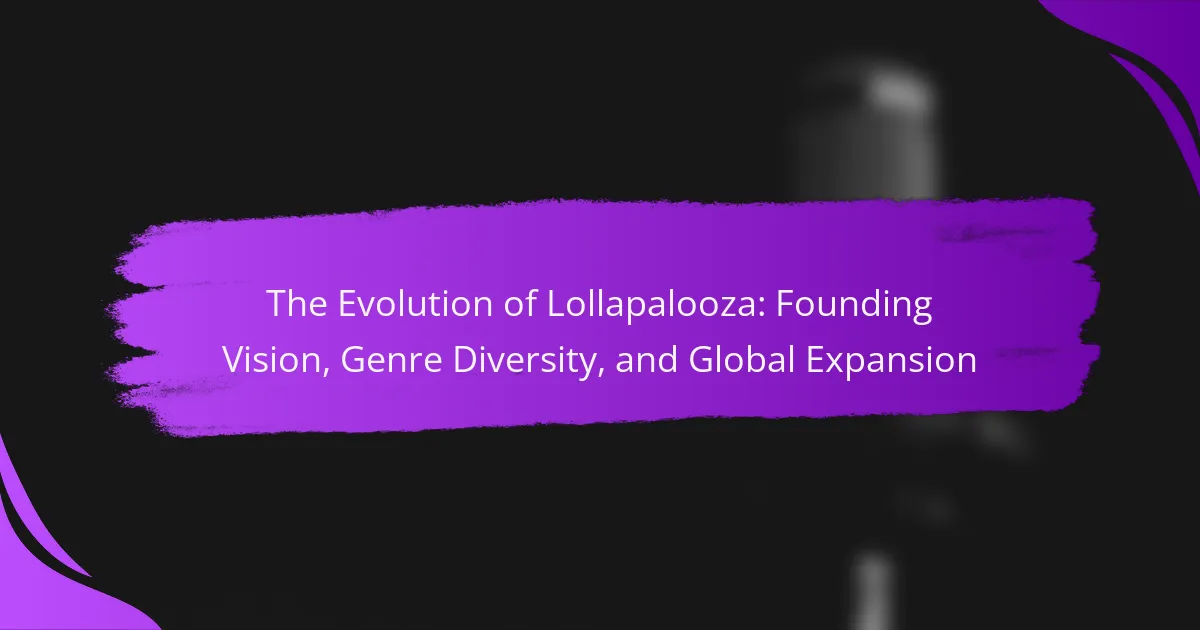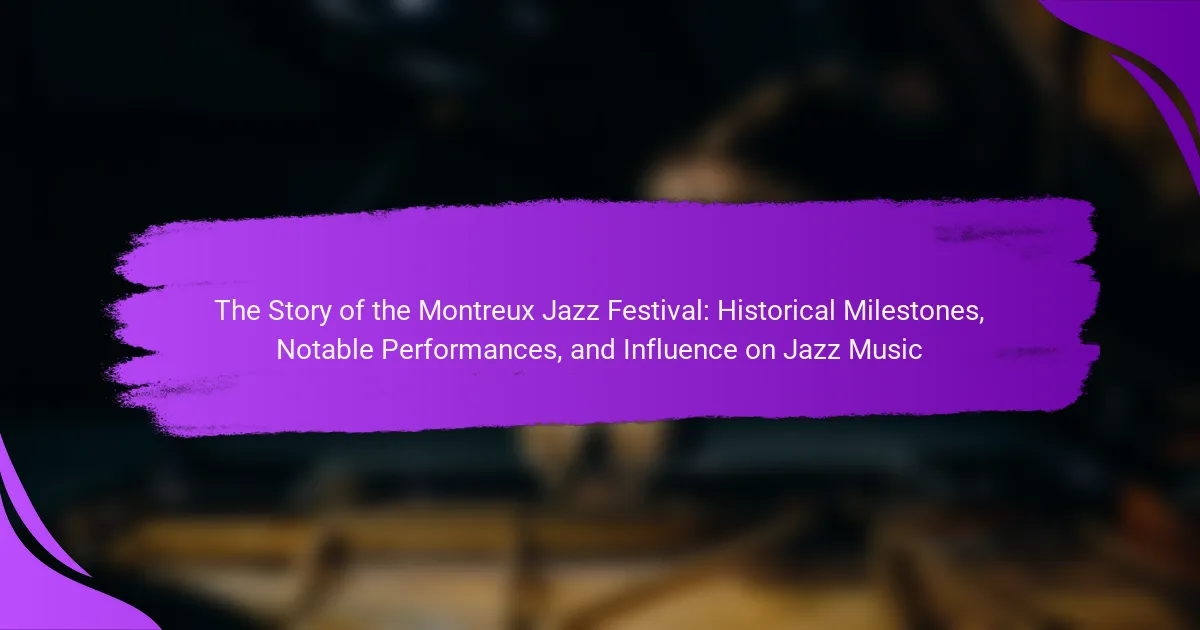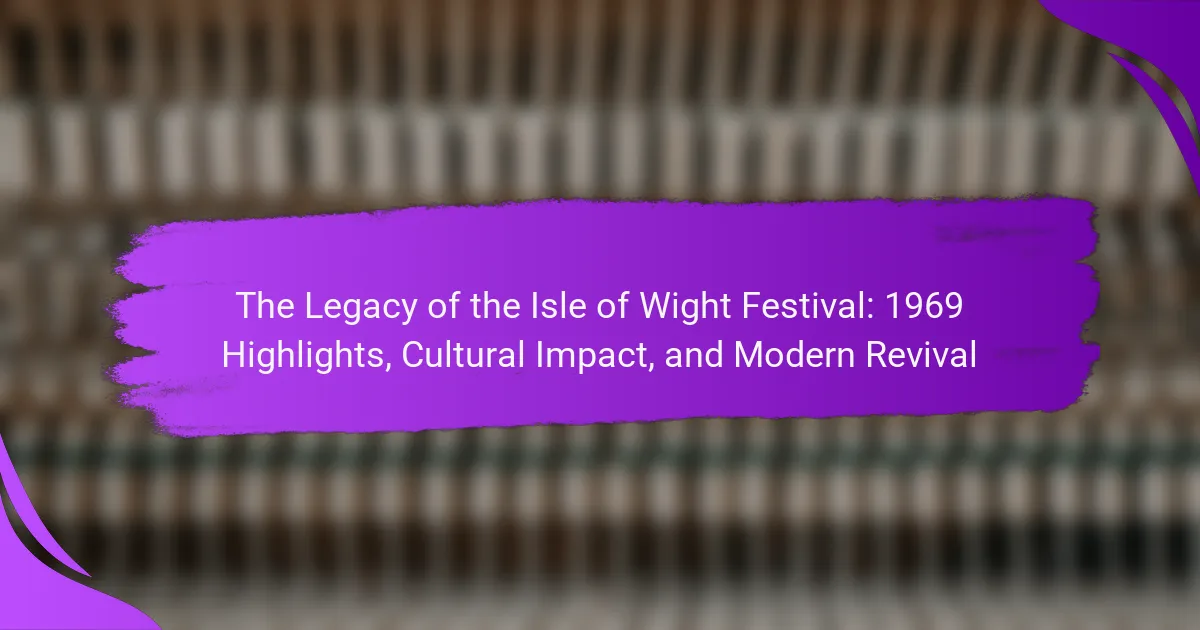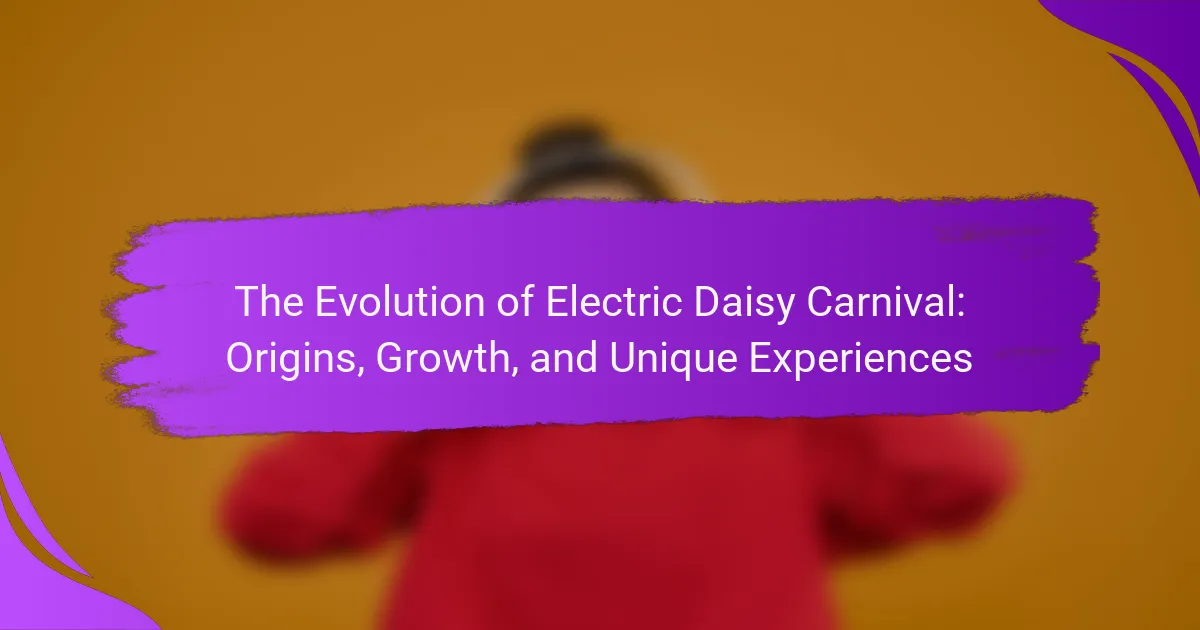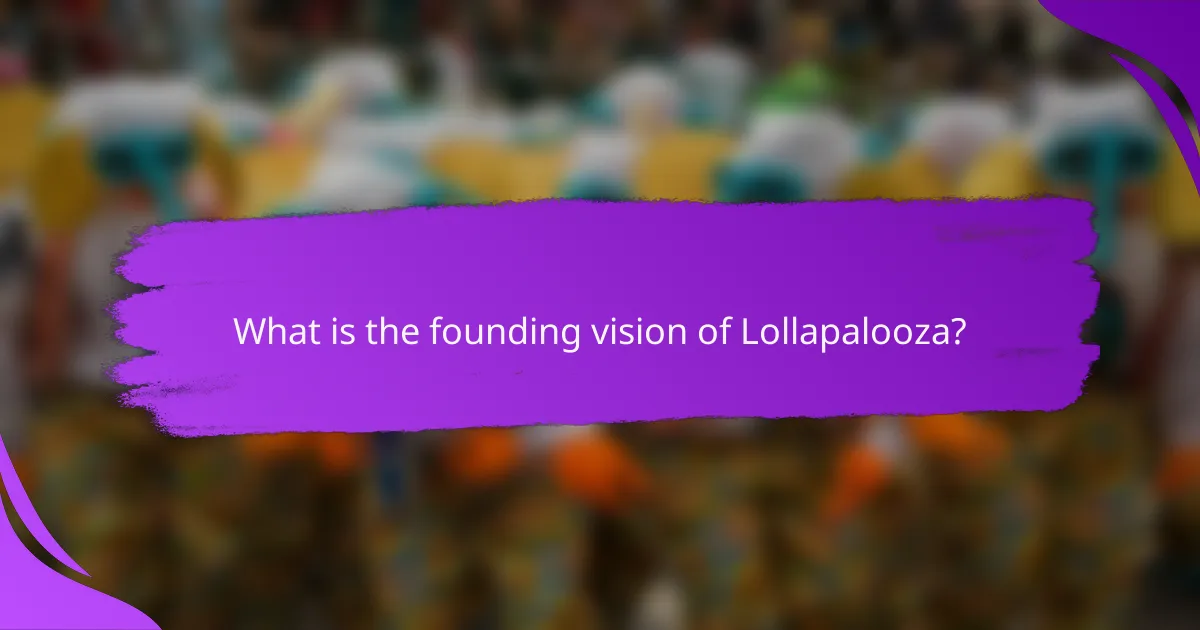
What is the founding vision of Lollapalooza?
The founding vision of Lollapalooza was to create a diverse music festival that showcased various genres. It aimed to promote alternative music and culture. Founded by Perry Farrell in 1991, it was initially conceived as a farewell tour for his band, Jane’s Addiction. The festival sought to unite different musical styles and bring together fans from various backgrounds. Lollapalooza also included art, activism, and community engagement as core components. This vision has evolved, leading to its expansion into an international festival brand. Today, it features a wide array of artists and genres, maintaining its commitment to diversity.
How did Perry Farrell conceptualize Lollapalooza?
Perry Farrell conceptualized Lollapalooza as a touring festival to showcase alternative music. He aimed to create a platform for diverse musical acts and cultural experiences. The first event took place in 1991, blending music with art and activism. Farrell envisioned it as a celebration of community and creativity. He wanted to unite various genres and promote emerging artists. The festival’s name was inspired by a term he used to describe something extraordinary. Farrell’s vision emphasized inclusivity and artistic expression. Lollapalooza has since evolved into a global phenomenon, maintaining its core values.
What were the initial goals and objectives of the festival?
The initial goals and objectives of the festival were to create a diverse music experience and promote various genres. Lollapalooza aimed to showcase alternative rock and other genres, appealing to a broad audience. The festival sought to provide a platform for emerging artists alongside established acts. Additionally, it aimed to foster a sense of community among music fans. The founders envisioned a traveling festival that would reach multiple cities. This concept was designed to make live music accessible to a wider demographic. The festival also intended to incorporate arts and crafts, enhancing the overall experience. These foundational goals shaped Lollapalooza’s identity and growth in subsequent years.
How did the cultural context of the early 1990s influence its founding?
The cultural context of the early 1990s significantly influenced the founding of Lollapalooza. This period was marked by a rise in alternative rock and grunge music, with bands like Nirvana and Pearl Jam gaining massive popularity. The disillusionment of Generation X played a crucial role in shaping the festival’s ethos, focusing on themes of rebellion and self-expression. Additionally, the early 90s saw the emergence of the DIY punk ethos, encouraging independent artists and labels. The increasing acceptance of multiculturalism also influenced Lollapalooza’s genre diversity, welcoming various musical styles. The festival’s founder, Perry Farrell, aimed to create a platform for diverse voices in music. This cultural backdrop led to a unique festival that reflected the social and musical landscape of its time.
What role did Lollapalooza play in the music industry?
Lollapalooza played a significant role in shaping the modern music festival landscape. It introduced the concept of multi-genre festivals in the early 1990s. This format allowed diverse musical acts to share the stage, promoting genre exploration among audiences. Lollapalooza also provided a platform for emerging artists. Many now-famous acts gained exposure through the festival. The event’s global expansion further influenced the international festival scene. By establishing a model for large-scale festivals, Lollapalooza set industry standards for production and artist engagement. Its success has inspired numerous similar festivals worldwide, reinforcing its impact on the music industry.
How did it impact the alternative music scene?
Lollapalooza significantly impacted the alternative music scene by providing a prominent platform for emerging bands. It showcased diverse genres, expanding the audience for alternative music. The festival introduced alternative acts to mainstream audiences, enhancing their visibility. Iconic performances by bands like Nirvana and Pearl Jam solidified their influence. Lollapalooza also fostered a sense of community among fans and artists. It inspired similar festivals, promoting the alternative music genre globally. The festival’s legacy continues to shape the music landscape today.
What were the key milestones in its early years?
Lollapalooza’s key milestones in its early years include its founding in 1991 by Perry Farrell. The first festival took place in July 1991 in Chicago. It was initially conceived as a farewell tour for Farrell’s band, Jane’s Addiction. The festival featured a diverse lineup, showcasing various genres and alternative music. In 1992, Lollapalooza expanded to multiple cities, enhancing its national presence. By 1994, the festival had established itself as an annual event, attracting larger crowds. The inclusion of non-musical acts, such as visual artists and vendors, began in 1995. In 1997, Lollapalooza went on hiatus, marking a significant shift in its trajectory. The festival was revived in 2003, leading to its eventual global expansion.
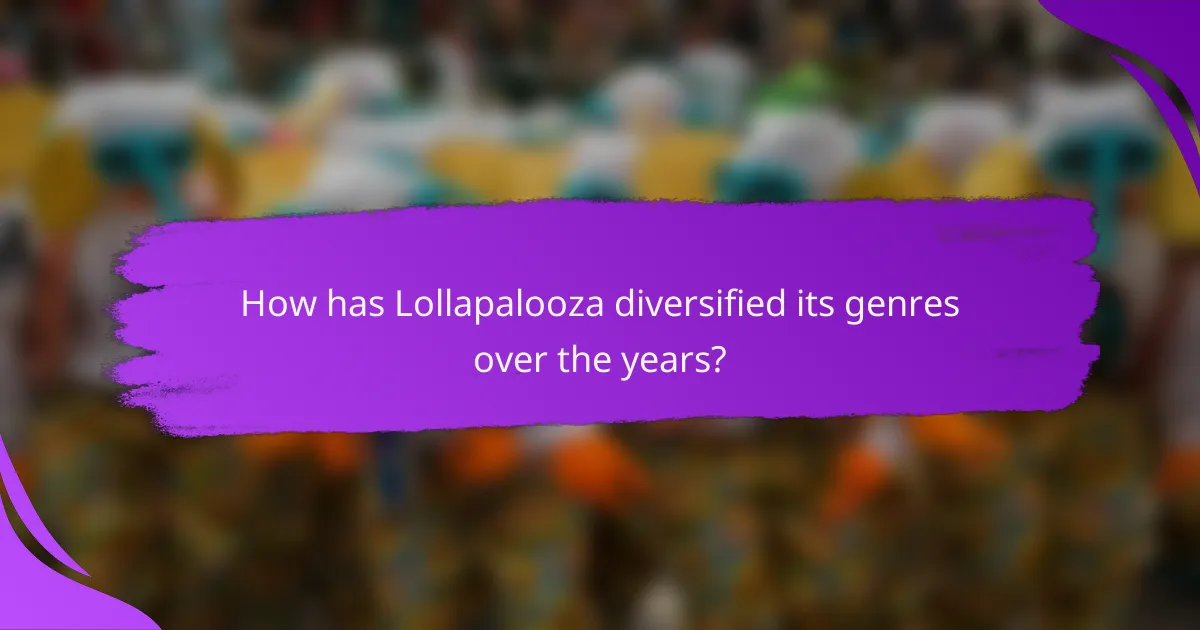
How has Lollapalooza diversified its genres over the years?
Lollapalooza has diversified its genres significantly since its inception in 1991. Initially focused on alternative rock, the festival now includes a wide range of genres. These genres encompass hip-hop, electronic dance music, pop, and indie rock. Over the years, Lollapalooza has featured artists from various musical backgrounds. The lineup has evolved to include mainstream acts alongside underground musicians. This diversification reflects changing music trends and audience preferences. For example, in 2022, the festival showcased artists like Dua Lipa and Metallica. The inclusion of diverse genres has attracted a broader audience. This evolution has solidified Lollapalooza’s reputation as a versatile music festival.
What genres have been featured at Lollapalooza?
Lollapalooza has featured a diverse range of genres. Rock, alternative, and punk are among the most prominent. Hip-hop and electronic music have also been significant. Indie and pop acts regularly appear on the lineup. Additionally, metal and folk genres have been represented. Over the years, Lollapalooza has showcased both emerging and established artists. This genre diversity reflects the festival’s commitment to a wide musical spectrum.
How has the lineup evolved from its inception to the present?
The Lollapalooza lineup has evolved significantly since its inception in 1991. Initially, it featured alternative rock and punk bands. Key acts included Jane’s Addiction and Siouxsie and the Banshees. Over the years, the lineup expanded to include a wider range of genres. Hip-hop, electronic, and pop artists began to appear prominently. In recent years, headliners have included global superstars like Ariana Grande and Travis Scott. This evolution reflects changing musical trends and audience preferences. The festival now showcases over 170 acts annually across multiple stages. This diverse lineup has contributed to Lollapalooza’s status as a premier music festival worldwide.
What are some notable genre-blending performances?
Notable genre-blending performances include those by artists like OutKast, who combined hip-hop with funk and rock. Their performance at Coachella 2014 showcased this fusion effectively. Another example is the collaboration between Billie Eilish and Khalid, blending pop with R&B elements during their live sets. Additionally, the band Gorillaz merges virtual and live performances, incorporating various genres like hip-hop, rock, and electronic music. These performances highlight the innovative spirit of genre-blending in contemporary music.
Why is genre diversity important for Lollapalooza?
Genre diversity is important for Lollapalooza because it enhances the festival’s appeal to a broader audience. A varied lineup attracts fans from different musical backgrounds. This diversity fosters a richer cultural experience. It allows attendees to discover new genres and artists. Lollapalooza has featured genres ranging from rock to hip-hop to electronic. This eclectic mix reflects current music trends and promotes inclusivity. The festival’s success is partly due to its ability to adapt to changing musical landscapes. By embracing genre diversity, Lollapalooza strengthens its position as a leading music festival.
How does it attract a wider audience?
Lollapalooza attracts a wider audience through its diverse lineup and global expansion. The festival features a mix of genres, appealing to various musical tastes. This diversity includes rock, hip-hop, pop, and electronic music. By showcasing both established and emerging artists, it draws fans from different backgrounds. Additionally, Lollapalooza’s expansion into international markets increases its reach. Festivals in countries like Brazil, Argentina, and Germany attract local attendees. The combination of genre variety and global presence enhances its audience appeal. This strategy has resulted in attendance growth, with over 400,000 people attending the Chicago festival in 2019.
What are the benefits of showcasing various music styles?
Showcasing various music styles enhances cultural appreciation and fosters inclusivity. It allows audiences to experience diverse sounds and traditions. Exposure to different genres promotes creativity among artists. This diversity can lead to unique collaborations and innovation in music. Festivals like Lollapalooza exemplify this by featuring multiple genres. They attract a broader audience, increasing attendance and engagement. Studies show that diverse lineups can enhance festival experiences and satisfaction. Overall, showcasing various music styles enriches the musical landscape and community connections.
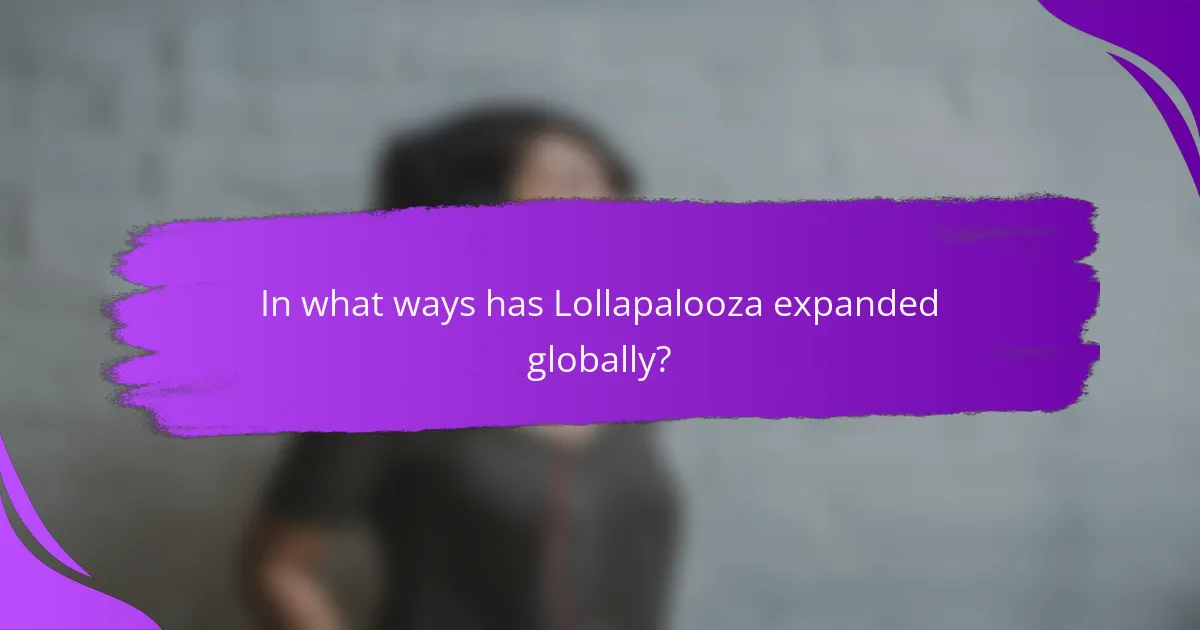
In what ways has Lollapalooza expanded globally?
Lollapalooza has expanded globally by launching festivals in multiple countries. Initially held in the United States, it began international expansion in 2011. The festival was first established in Chile, followed by events in Brazil and Argentina. In 2018, Lollapalooza debuted in Europe with a festival in Berlin, Germany. The brand has also expanded to Asia, with Lollapalooza India set to launch in 2023. Each international festival features diverse lineups and local artists. This global strategy has significantly increased Lollapalooza’s brand presence worldwide.
What are the key locations for Lollapalooza festivals outside the U.S.?
Lollapalooza festivals outside the U.S. are held in several key locations. Major international editions occur in Brazil, Argentina, and Germany. The festival in Brazil takes place in São Paulo. Argentina hosts Lollapalooza in Buenos Aires. In Germany, the event is held in Berlin. These locations have successfully embraced the festival format. They attract large audiences and feature diverse lineups. Each location showcases both international and local artists. These festivals contribute to Lollapalooza’s global expansion.
How did Lollapalooza adapt its model for international markets?
Lollapalooza adapted its model for international markets by customizing its festival experience to local cultures. This included tailoring lineups to feature regional artists alongside headliners. The festival also adjusted its marketing strategies to resonate with local audiences. Partnerships with local promoters helped facilitate smoother operations and logistics. Additionally, Lollapalooza incorporated local food and beverage offerings to enhance the attendee experience. The festival’s successful expansion into countries like Brazil and Argentina demonstrated its effective adaptation strategies. These changes ensured that Lollapalooza remained relevant and appealing in diverse international markets.
What challenges did it face during global expansion?
Lollapalooza faced several challenges during its global expansion. Cultural differences impacted audience reception in various countries. Local regulations regarding events and permits varied significantly. Competition from established local festivals created market saturation. Logistical issues arose in coordinating international acts and production. Currency fluctuations affected budgeting and financial planning. Additionally, adapting marketing strategies to resonate with diverse audiences proved difficult. These factors collectively hindered seamless global growth.
How does Lollapalooza maintain its brand identity across different cultures?
Lollapalooza maintains its brand identity across different cultures by emphasizing a consistent festival experience. This experience includes a diverse lineup of artists that reflects local musical tastes while still featuring globally recognized acts. The festival’s branding, including its logo and marketing materials, remains uniform across locations. Additionally, Lollapalooza promotes core values such as inclusivity and community engagement at all its events. The incorporation of local food, art, and cultural elements further enhances its appeal in various regions. This strategy allows Lollapalooza to resonate with local audiences while preserving its established identity. The festival has successfully expanded to cities like São Paulo and Berlin, adapting to cultural nuances without losing its essence.
What strategies are used to ensure a consistent festival experience?
Strategies used to ensure a consistent festival experience include standardizing operational procedures and maintaining quality control. Event organizers implement detailed guidelines for staff training and vendor management. Consistent branding across marketing materials reinforces the festival’s identity. Feedback mechanisms are established to gather attendee insights for improvement. Safety protocols are uniformly enforced to enhance attendee security. Scheduled programming ensures a balanced lineup across different stages. Partnerships with reliable sponsors contribute to a cohesive atmosphere. Historical data from previous events informs planning for logistics and crowd management.
How do local influences shape each festival’s unique character?
Local influences shape each festival’s unique character through cultural traditions, local music scenes, and community involvement. Each festival reflects the history and values of its location. For instance, Lollapalooza in Chicago incorporates local artists and regional food vendors. This creates a distinct atmosphere that resonates with the local audience. Festivals often highlight regional issues or themes, fostering a sense of belonging. Additionally, local partnerships with businesses enhance the festival experience. These collaborations can lead to unique merchandise and promotions. Overall, local influences are crucial in defining the character of each festival.
What are the future trends for Lollapalooza?
Future trends for Lollapalooza include increased genre diversity and enhanced digital experiences. The festival is likely to feature a broader range of musical genres, appealing to wider audiences. This aligns with past trends where Lollapalooza incorporated various styles, from rock to electronic music.
Additionally, the integration of technology is expected to grow. Virtual reality experiences and live streaming options are becoming more common at festivals. These innovations allow fans to engage with performances remotely.
Sustainability initiatives will also play a significant role in the festival’s future. Lollapalooza has previously committed to reducing its environmental impact. This trend is expected to continue, focusing on eco-friendly practices and waste reduction.
Overall, Lollapalooza is poised to evolve by embracing diversity, technology, and sustainability in its upcoming events.
How might Lollapalooza evolve in response to changing music trends?
Lollapalooza may evolve by incorporating emerging music genres and artists into its lineup. As musical tastes shift, the festival can adapt by featuring popular genres like electronic dance music or hip-hop. This strategy aligns with past trends where Lollapalooza included acts like Billie Eilish and Post Malone, reflecting audience preferences. Additionally, the festival can enhance its digital presence through virtual experiences and live-streaming. This move would cater to a broader audience, especially those unable to attend in person. Historical data shows that festivals integrating technology see increased engagement. By staying attuned to music trends, Lollapalooza can maintain relevance and attract diverse audiences.
What innovations could enhance the festival experience going forward?
Innovations that could enhance the festival experience include advanced technology integration, such as augmented reality (AR) and virtual reality (VR). AR can provide interactive maps and real-time updates for attendees. VR experiences can engage festival-goers in immersive environments, even from home. Sustainable practices, like cashless transactions and eco-friendly materials, can improve convenience and reduce waste. Enhanced mobile apps can offer personalized schedules and artist recommendations based on user preferences. Additionally, improved crowd management technologies can ensure safety and comfort during events. Data analytics can help organizers tailor experiences to attendee feedback, enhancing overall satisfaction. These innovations have been shown to increase engagement and enjoyment at large-scale events.
The main entity of this article is Lollapalooza, a music festival founded by Perry Farrell in 1991. The article outlines Lollapalooza’s founding vision of promoting diverse musical genres and alternative culture, its evolution into a global festival brand, and its significant impact on the music industry. Key topics include the festival’s initial goals, the influence of the early 1990s cultural context, how it has diversified its lineup over the years, and its expansion into international markets. Additionally, the article discusses the challenges faced during global growth, strategies for maintaining brand identity, and future trends in music and technology for Lollapalooza.
